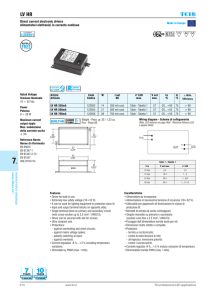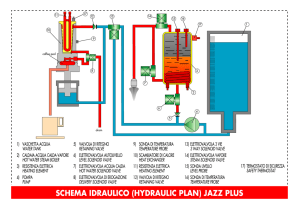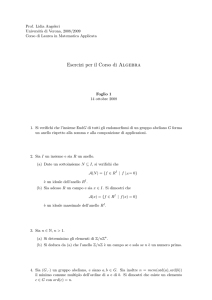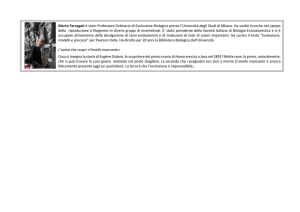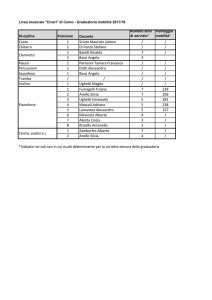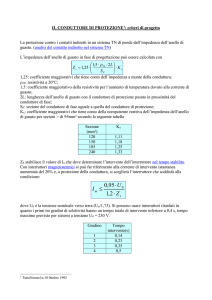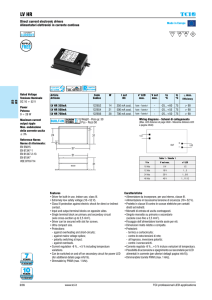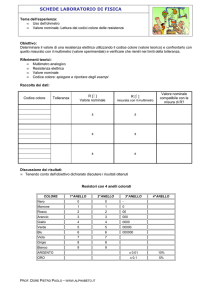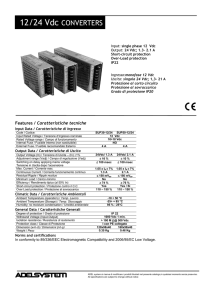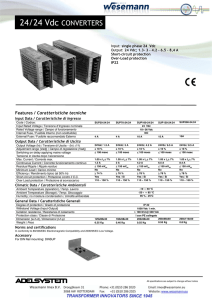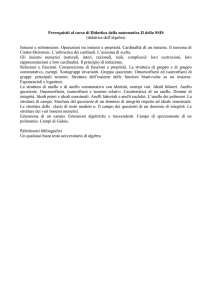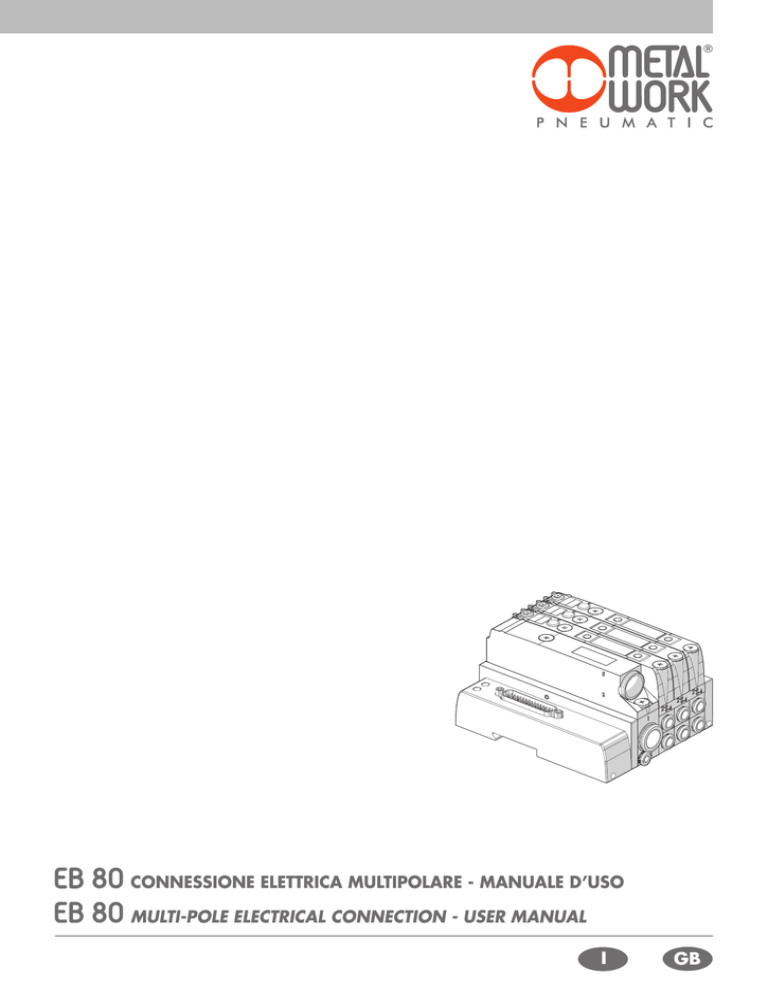
CONNESSIONE ELETTRICA MULTIPOLARE - MANUALE D’USO
MULTI-POLE ELECTRICAL CONNECTION - USER MANUAL
I
GB
1. INSTALLAZIONE E COLLEGAMENTI ELETTRICI
1.1 COLLEGAMENTO DELLA CONNESSIONE ELETTRICA MULTIPOLARE
L’isola EB 80 è dotata di un’elettronica di controllo, quindi è necessaria una alimentazione elettrica fissa.
L’alimentazione ed il comando delle elettrovalvole dell’isola, si effettuano attraverso un connettore D-Sub 25 o 44 poli. Il connettore 25 poli consente
di comandare fino a 21valvole (elettropiloti), il connettore 44 poli consente di comandare fino a 38 valvole (elettropiloti). Il tipo di comando può
essere configurato PNP o NPN, collegando il pin CONFIG PNP/NPN, rispettivamente al polo positivo se i comandi sono di tipo PNP, o al polo
negativo se i comandi sono di tipo NPN. Un eventuale guasto viene segnalato dall’attivazione di un uscita dedicata, dello stesso tipo, PNP o NPN,
configurato per i comandi, che può essere collegata ad un ingresso del sistema di controllo per un’adeguata gestione dell’evento.
I
CONNETTORE VASCHETTA 25 POLI PRECABLATO
Posizione contatto
elettrico
1
2
3
4
5
6
7
8
9
10
11
12
13
14
15
16
17
18
19
20
21
22
23
24
25
Colore conduttore
corrispondente
Bianco
Marrone
Verde
Giallo
Grigio
Rosa
Blu
Rosso
Nero
Viola
Grigio + anello Rosa
Rosso + anello Blu
Bianco + anello Verde
Marrone + anello Verde
Bianco + anello Giallo
Giallo + anello Marrone
Bianco + anello Grigio
Grigio + anello Marrone
Bianco + anello Rosa
Rosa + anello Marrone
Bianco + anello Blu
Marrone + anello Blu
Bianco + anello Rosso
Marrone + anello Rosso
Bianco + anello Nero
Funzione
Out 1
Out 2
Out 3
Out 4
Out 5
Out 6
Out 7
Out 8
Out 9
Out 10
Out 11
Out 12
Out 13
Out 14
Out 15
Out 16
Out 17
Out 18
Out 19
Out 20
Out 21
Segnalazione guasto
Config. PNP/NPN
+ 24VDC
0VDC
CONNETTORE VASCHETTA 44 POLI PRECABLATO
Posizione contatto
elettrico
1
2
3
4
5
6
7
8
9
10
11
12
13
14
15
16
17
18
19
20
21
22
23
24
25
26
27
28
29
30
31
32
33
34
35
36
37
38
39
40
41
42
43
44
Colore conduttore
corrispondente
Bianco
Marrone
Verde
Giallo
Grigio
Rosa
Blu
Rosso
Nero
Viola
Grigio + anello Rosa
Rosso + anello Blu
Bianco + anello Verde
Marrone + anello Verde
Bianco + anello Giallo
Giallo + anello Marrone
Bianco + anello Grigio
Grigio + anello Marrone
Bianco + anello Rosa
Rosa + anello Marrone
Bianco + anello Blu
Marrone + anello Blu
Bianco + anello Rosso
Marrone + anello Rosso
Bianco + anello Nero
Marrone + anello Nero
Grigio + anello Verde
Giallo + anello Grigio
Rosa + anello Verde
Giallo + anello Rosa
Verde + anello Blu
Giallo + anello Blu
Verde + anello Rosso
Giallo + anello Rosso
Verde + anello Nero
Giallo + anello Nero
Grigio + anello Blu
Rosa + anello Blu
Grigio + anello Rosso
Rosa + anello Rosso
Grigio + anello Nero
Rosa + anello Nero
Blu + anello Nero
Rosso + anello Nero
Funzione
Out 1
Out 2
Out 3
Out 4
Out 5
Out 6
Out 7
Out 8
Out 9
Out 10
Out 11
Out 12
Out 13
Out 14
Out 15
Out 16
Out 17
Out 18
Out 19
Out 20
Out 21
Out 22
Out 23
Out 24
Out 25
Out 26
Out 27
Out 28
Out 29
Out 30
Out 31
Out 32
Out 33
Out 34
Out 35
OUT 36
OUT 37
OUT 38
Segnalazione guasto
Config. PNP/NPN
+ 24VDC
+ 24VDC
0VDC
0VDC
ATTENZIONE
Disattivare la tensione prima di inserire o disinserire il connettore (pericolo di danni funzionali)
Utilizzare solamente unità di valvole completamente assemblate.
Per l’alimentazione utilizzare esclusivamente alimentatori a norma IEC 742/EN60742/VDE0551 con resistenza minima di isolamento di 4kV (PELV).
L’isola deve essere collegata a terra utilizzando la connessione del terminale di chiusura, indicata con il simbolo PE
In caso di scariche elettrostatiche, la mancanza di collegamento a terra può causare malfunzionamenti e danni irreversibili.
2
1.2 TENSIONE DI ALIMENTAZIONE
Il sistema consente un range di alimentazione ampio, da 12VDC – 10% a 24VDC +30% ovvero da una tensione minima di 10.8VDC ad una tensione
massima di 31.2VDC.
ATTENZIONE
Una tensione maggiore di 32VDC danneggia irreparabilmente il sistema.
1.3 CORRENTE ASSORBITA
Il controllo delle elettrovalvole avviene attraverso una scheda elettronica dotata di microprocessore.
Per garantire un azionamento sicuro della valvola e ridurre il consumo energetico, il comando è di tipo “speed up”, cioè all’elettropilota vengono
forniti 3W per 15 millisecondi e successivamente la potenza viene ridotta gradualmente a 0.3W. Il microprocessore attraverso un comando PWM
regola la corrente circolante nella bobina, che rimane costante indipendentemente dalla tensione di alimentazione e dalla temperatura, mantenendo
di conseguenza inalterato il campo magnetico generato dall’elettropilota.
Per dimensionare correttamente l’alimentazione del sistema si deve tener conto di quante valvole dovranno essere comandate simultaneamente*
e quante sono già attive.
*Per comando simultaneo si intende l’attivazione di tutti gli elettropiloti che hanno tra loro una differenza temporale minore di 15 millisecondi.
P1
P2
P3
T1
T2
T1 = P1 + P2 + P3 = 3 elettropiloti simultanei
T2 = P2 + P3
= 2 elettropiloti simultanei
Esempio:
Tensione di alimentazione 12VDC
Tensione di alimentazione 24VDC
La potenza totale assorbita in ingresso è uguale alla potenza assorbita dagli elettropiloti più
la potenza assorbita dall’elettronica di controllo delle basi. Per semplificare il calcolo si può
considerare 3.2W la potenza di ogni elettropilota simultaneo e 0.3W la potenza di ogni
elettropilota attivo.
I max [A] = N° elettropiloti simultanei x 3.2 + N° elettropiloti attivi x 0.3
VDC
Esempio:
N° elettropiloti simultanei = 10
N° elettropiloti attivi = 15
VDC = Tensione di alimentazione 24
I max = 10 x 3.2 +15 x 0.3 = 1.5 A
24
N° valvole attive
10
5
0
10
5
20
N° valvole comandate simultaneamente
3
5
20
10
5
10
I
15 ms
Corrente totale [A]
1
1.35
5
1.35
0.7
1.5
1.3.1 Caduta di tensione del sistema
La caduta di tensione dipende dalla corrente massima assorbita dal sistema e dalla lunghezza del cavo di connessione al sistema.
In un sistema alimentato a 24VDC con lunghezze del cavo fino a 20 m non è necessario tenere conto delle cadute di tensione.
In un sistema alimentato a 12VDC, si deve garantire che la tensione fornita sia sufficiente per il corretto funzionamento. È necessario tenere conto
delle cadute di tensione dovute al numero di elettrovalvole attive, al numero di valvole comandate simultaneamente e alla lunghezza del cavo.
La tensione reale che arriva agli elettropiloti deve essere almeno 10.8 V.
Riportiamo qui in sintesi l’algoritmo per la verifica.
Corrente massima: I max [A] = N° elettropiloti comandati simultaneamente x 4 + N° elettropiloti attivi x 0.5
VDC
Caduta di tensione: con connettore a 25 poli: ΔV = Imax [A] x Rs [0.067Ω/m] x 2L [m]
Caduta di tensione: con connettore a 44 poli: ΔV = Imax [A] x Rs [0.067Ω/m] x L [m]
Ove Rs è la resistenza del cavo ed L la sua lunghezza.
La tensione all’ingresso del cavo, Vin deve essere almeno pari a 10.8 V + ΔV
Esempio:
Tensione di alimentazione 12 V, cavo lungo 5 m, connettore a 25 PIN, si attivano contemporaneamente 3 piloti mentre altri 10 sono già attivi:
I max = 3x4 + 10x0.5 = 1.41 A
ΔV = (1.41 x 0.067 x 2x5) = 0.95 V
12
Perciò all’alimentatore serve una tensione maggiore o uguale a 10.8 + 0.95 = 11.75 V
Vin =12 V > 11.75 --> OK
3
1.3.2 Cadute di tensione sui cavi
Se il numero di elettrovalvole che vengono attivate simultaneamente è
elevato, si deve tenere conto della caduta di tensione di alimentazione
sui cavi di collegamento, causata dal passaggio di corrente.
Nel caso in cui la caduta di tensione sia tale da pregiudicare il corretto
funzionamento del sistema, è necessario inserire un intermedio con
alimentazione elettrica supplementare, descritto al paragrafo 4.
Esempio:
Lunghezza
cavo [m]
1
5
10
Corrente Caduta di tensione Caduta di tensione Caduta di tensione
[A]
cavo 25 poli [V]
cavo 44 poli [V]
cavo M8 [V]
1
0.15
0.08
0.08
3
0.4
0.2
0.2
5
0.7
0.35
0.35
1
0.7
0.35
0.35
3
2
1
1
5
3.4
1.7
1.7
1
1.35
0.7
0.7
3
4
2
2
5
6.7
3.4
3.4
2. PROTEZIONI E DIAGNOSTICA DEL SOTTOINSIEME CONNESSIONE ELETTRICA MULTIPOLARE
L’isola è protetta da sovraccarichi. NON è ammessa una inversione di polarità se non per pochi secondi. Per evitare danni permanenti, è necessario
utilizzare un alimentatore protetto da cortocircuiti o installare un dispositivo di protezione, ad esempio un fusibile, adeguatamente dimensionato in
funzione della corrente massima assorbita dal sistema. Per il calcolo della corrente massima fare riferimento al paragrafo 1.2.3 del manuale.
In caso di cortocircuito dell’elettropilota, segnalato dall’accensione del Led rosso Error e dal lampeggio del Led della valvola guasta, solo la valvola
guasta viene disconnessa. Il guasto viene segnalato al sistema di controllo tramite l’out Segnalazione GUASTO. Togliere l’alimentazione elettrica e
rimuovere la causa del guasto per resettare la segnalazione di allarme.
In caso di comando di un pilota interrotto o di una posizione con elettropilota mancante, l’anomalia viene segnalata dall’accensione del Led rosso
Error, e dal lampeggio del Led della valvola guasta; solo la valvola guasta viene disconnessa. Il guasto viene segnalato al sistema di controllo tramite
l’out Segnalazione GUASTO. L’uscita si ripristina automaticamente rimuovendo la causa. Togliere l’alimentazione elettrica e rimuovere la causa del
guasto per resettare la segnalazione di allarme.
In caso di tensione di alimentazione fuori range, l’anomalia viene segnalata dall’accensione del Led rosso Error, e dal lampeggio di tutti i Led delle
valvole. Il guasto viene segnalato al sistema di controllo tramite l’out Segnalazione GUASTO. Le elettrovalvole continuano a funzionare, fino a che, in
caso di tensione troppo bassa, essa non scenda al di sotto dei limiti di funzionamento degli elettropiloti.
I
2.1 VISUALIZZAZIONE DELLA DIAGNOSTICA
2.1.1 Diagnostica della connessione elettrica multipolare
La diagnostica della connessione elettrica multipolare è definita dallo stato dei Led di interfaccia.
La generazione di un allarme attiva l’Out Segnalazione GUASTO.
Led Verde
Power
ON (verde)
Led Rosso
Error
OFF
Significato
ON (verde)
ON (rosso)
Guasto nelle basi valvola
Il modulo funziona correttamente
2.1.2 Diagnostica delle basi per valvole
La diagnostica delle basi per valvola è definita dallo stato dei Led di interfaccia.
La generazione di un allarme attiva l’Out Segnalazione GUASTO e il Led Error del sottoinsieme Connessione elettrica multipolare.
Led Verde
Base
Significato
Stato dell’Out Segnalazione GUASTO e memorizzazione
OFF
L’uscita non è comandata
Out Segnalazione GUASTO - OFF
ON (verde)
L’uscita è attiva e funziona correttamente
Out Segnalazione GUASTO - OFF
VERDE
Segnalazione per ogni singola uscita.
Elettropilota interrotto o mancante (falsa valvola o valvola con un elettropilota
installata su una base per due elettropiloti)
Segnalazione per ogni singola uscita.
Elettropilota o uscita della base in cortocircuito
Out Segnalazione GUASTO - Attiva
L’uscita è Auto-ripristinante se la causa del guasto viene rimossa.
La segnalazione GUASTO è resettabile solo togliendo l’alimentazione elettrica.
Out Segnalazione GUASTO - Attiva, Permanente.
L’uscita viene spenta. Resettabile solo togliendo l’alimentazione elettrica.
(doppio lampeggio)
VERDE
(lampeggiante)
VERDE
(lampeggio
di tutti i Led della base)
4
Tensione di alimentazione fuori range Minore di 10.8V o maggiore di 31.2V Out Segnalazione GUASTO - Attiva, Auto-ripristinante rientrando nel range
Attenzione: una tensione maggiore di 32VDC danneggia irreparabilmente di funzionamento. Le segnalazioni permangono 5 secondi dopo il rientro nel
range di funzionamento.
il sistema.
3. COLLEGAMENTO ALLE VALVOLE
Il collegamento delle valvole avviene attraverso la scheda elettronica installata nella base.
Le basi sono di 4 tipi:
• a 3 posizioni per comandare 3 elettropiloti;
• a 3 posizioni per comandare 6 elettropiloti;
• a 4 posizioni per comandare 4 elettropiloti;
• a 4 posizioni per comandare 8 elettropiloti.
Le basi possono essere tutte connesse tra loro indifferentemente, fino ad occupare tutti i comandi consentiti dal connettore multipolare utilizzato.
Ogni base occupa sempre i comandi disponibili anche se non vengono utilizzati. Ciò consente di modificare la configurazione delle valvole installate,
senza modificare la mappatura degli indirizzi nel sistema di controllo.
ATTENZIONE
Il comando di uscite non connesse genera un allarme di elettropiloti interrotto.
CONNETTORE D-Sub 25 POLI
a Base a 3 posizioni per 6 piloti
b Base a 3 posizioni per 3 piloti
c Valvola con 2 elettropiloti
d Falsa valvola o bypass
e Valvola con 1 elettropilota
fIntermedio
g Base a 4 posizioni per 8 piloti
h Terminale cieco
I
OUT Segnalazione Guasto
CONNETTORE D-Sub 44 POLI
OUT Segnalazione Guasto
5
4. INTERMEDIO CON ALIMENTAZIONE ELETTRICA SUPPLEMENTARE
Tra le basi delle valvole possono essere installati dei moduli intermedi con alimentazione elettrica supplementare.
Possono servire come alimentazione elettrica supplementare, quando il numero di elettropiloti azionato contemporaneamente è elevato, oppure per
separare elettricamente alcune parti dell’isola da altre, per esempio quando si vuole interrompere l’alimentazione elettrica di alcune elettrovalvole
all’apertura di una protezione della macchina, o alla pressione di un pulsante di emergenza. Solo le elettrovalvole a valle del modulo sono alimentate
dallo stesso.
VDC Valvole
PIN
1
2
3
4
Colore
Marrone
Bianco
Blu
Nero
Funzione
+ VDC
+ VDC
GND
GND
VDC Valvole
VDC Valvole
VDC Bus
VDC Bus
Linea Bus
Linea Bus
ATTENZIONE
Non può essere utilizzata come funzione di sicurezza, in quanto garantisce solo che non venga effettuata nessuna attivazione elettrica.
Attivazioni manuali o guasti possono causare movimenti involontari. Per maggior sicurezza, scaricare l’impianto pneumatico prima di eseguire
interventi pericolosi.
I
5. DATI TECNICI
Range di tensione di alimentazione
Tensione minima di funzionamento
Tensione massima di funzionamento
Tensione massima ammissibile
Azionamento
Potenza di alimentazione senza valvole comandate
Potenza elettropilota all’accensione (Speed Up)
Potenza elettropilota dopo la fase di accensione (mantenimento)
Corrente massima ammissibile
Protezioni
V
V
V
V
W
W
W
A
Diagnostica
Guasti segnalati
Temperatura ambiente
°C
°F
Connessione elettrica
Numero massimo di elettropiloti comandabili
Numero massimo di elettrovalvole comandabili
Numero massimo di elettropiloti comandabili contemporaneamente:
a 24VDC
a 12VDC
Corrente massima a 24VDC
Corrente massima a 12VDC
Grado di protezione
24 +30%
10.8
31.2
32*
PNP o NPN configurabile
0.1 per “Connessione elettrica - E” + 0.25 per ogni “Base - B”
3 per 15 msec
0.3
6 continuativi, 9 istantanei
Sistema protetto da sovraccarico;
uscita elettropilota protetto da cortocircuito
Led rosso e attivazione Out segnalazione GUASTO su “Connessione elettrica - E”
Segnalazione Led sulla valvola
Elettropilota in corto circuito; Elettropilota interrotto o mancante
Tensione di alimentazione fuori range (under voltage e over voltage)
-10 ÷ + 50
14 ÷ 122
Connettori a vaschetta
Connettore 25 PIN
Connettore 44 PIN
21
38
Idem, in funzione del numero di elettropiloti e della tipologia di base
A
A
* ATTENZIONE: una tensione maggiore di 32VDC danneggia irreparabilmente il sistema.
6
12 -10%
21
38
In funzione della caduta di tensione - vedere pagina 3
3
5
6
9
IP65 (con i connettori collegati o tappati se non utilizzati)
1. INSTALLATION AND ELECTRICAL CONNECTION
1.1 MULTI-PIN ELECTRICAL CONNECTION
The EB 80 valve island is equipped with an electronic control module, which requires fixed electrical power.
The valves are supplied and controlled by either a D-Sub 25-pin or a 44-pin connector. The 25-pin connector can control up to 21 valves (solenoids);
the 44-pin connector can control up to 38 valves (solenoids). The type of control can be either PNP or NPN configured by connecting the PNP/NPN
CONFIG pin to the positive pole in the case of PNP logic or to the negative pole in the case of NPN logic. Any failure is signalled by the activation
of a dedicated output of the same type, either PNP or NPN, which is configured for the controls and can be connected to a control system input for
proper management.
Position of
electrical contact
1
2
3
4
5
6
7
8
9
10
11
12
13
14
15
16
17
18
19
20
21
22
23
24
25
Colour of the
corresponding wire
White
Brown
Green
Yellow
Grey
Pink
Blue
Red
Black
Violet
Grey + Pink ring
Red + Blue ring
White + Green ring
Brown + Green ring
White + Yellow ring
Yellow + Brown ring
White + Grey ring
Grey + Brown ring
White + Pink ring
Pink + Brown ring
White + Blue ring
Brown + Blue ring
White + Red ring
Brown + Red ring
White + Black ring
44-PIN PRE-WIRED PLUG CONNECTOR
Function
Out 1
Out 2
Out 3
Out 4
Out 5
Out 6
Out 7
Out 8
Out 9
Out 10
Out 11
Out 12
Out 13
Out 14
Out 15
Out 16
Out 17
Out 18
Out 19
Out 20
Out 21
Fault reporting
Config. PNP/NPN
+ 24VDC
0VDC
Position of
electrical contact
1
2
3
4
5
6
7
8
9
10
11
12
13
14
15
16
17
18
19
20
21
22
23
24
25
26
27
28
29
30
31
32
33
34
35
36
37
38
39
40
41
42
43
44
Colour of the
corresponding wire
White
Brown
Green
Yellow
Grey
Pink
Blue
Red
Black
Violet
Grey + Pink ring
Red + Blue ring
White + Green ring
Brown + Green ring
White + Yellow ring
Yellow + Brown ring
White + Grey ring
Grey + Brown ring
White + Pink ring
Pink + Brown ring
White + Blue ring
Brown + Blue ring
White + Red ring
Brown + Red ring
White + Black ring
Brown + Black ring
Grey + Green ring
Yellow + Grey ring
Pink + Green ring
Yellow + Pink ring
Green + Blue ring
Yellow + Blue ring
Green + Red ring
Yellow + Red ring
Green + Black ring
Yellow + Black ring
Grey + Blue ring
Pink + Blue ring
Grey + Red ring
Pink + Red ring
Grey + Black ring
Pink + Black ring
Blue + Black ring
Red + Black ring
Function
Out 1
Out 2
Out 3
Out 4
Out 5
Out 6
Out 7
Out 8
Out 9
Out 10
Out 11
Out 12
Out 13
Out 14
Out 15
Out 16
Out 17
Out 18
Out 19
Out 20
Out 21
Out 22
Out 23
Out 24
Out 25
Out 26
Out 27
Out 28
Out 29
Out 30
Out 31
Out 32
Out 33
Out 34
Out 35
OUT 36
OUT 37
OUT 38
Fault reporting
Config. PNP/NPN
+ 24VDC
+ 24VDC
0VDC
0VDC
GB
25-PIN PRE-WIRED PLUG CONNECTOR
WARNING!
Power off the system before plugging or unplugging the connector (risk of functional damage).
Only use fully assembled valve units.
Only use power supply units to IEC 742/EN60742/VDE0551 standards with a minimum insulation resistance of 4kV (PELV).
Earth the module using the end plate connection, identified with PE
Failure to earth the system properly may cause malfunctions and serious damage in the event of electrostatic discharge.
7
1.2 SUPPLY VOLTAGE
The system is designed to operate with wide power ratings, ranging from 12VDC -10% to 24VDC +30%, i.e. with a minimum voltage rating of
10.8VDC and a maximum of 31.2VDC.
WARNING!
Voltage greater than 32VDC will damage the system irreparably.
1.3 INPUT CURRENT
Solenoid valves are controlled via an electronic board equipped with a microprocessor.
In order to ensure safe operation of the valve and reduce energy consumption, a “speed-up” control is provided, i.e. 3W is supplied to solenoid pilot
for 15 milliseconds and then power is gradually reduced to 0.25W. The microprocessor regulates, via a PWM control, the current in the coil, which
remains constant regardless of the supply voltage and temperature, thus keeping the magnetic field generated by the solenoid pilot unchanged.
For the system power supply to be properly scaled, it is important to take into account the number of valves to be controlled simultaneously* and the
number of those already active.
*By simultaneous control is meant the activation of all solenoid pilots with a time difference less than 15 milliseconds.
Total current consumption is equal to the power consumed by the solenoid pilots plus the current
consumed by the electronics controlling the bases. To simplify the calculation, you can consider
3.2W consumed by each solenoid pilot simultaneously and 0.3W by each active solenoid pilot.
15 ms
P1
P2
P3
GB
T1
I max [A] = No. of simultaneously-controlled solenoid pilots x 3.2 + no. of active solenoid pilots x 0.3 VDC
Example:
No. of simultaneously-controlled solenoid pilots = 10
No. of active solenoid pilots = 15
VDC = Supply voltage 24
T2
T1 = P1 + P2 + P3 = 3 simultaneously-controlled solenoid pilots
T2 = P2 + P3
= 2 simultaneously-controlled solenoid pilots
Example:
Supply voltage 12VDC
Supply voltage 24VDC
I max = 10 x 3.2 +15 x 0.3 = 1.5 A
24
No. of active valves
10
5
0
10
5
20
No. of valves controlled simultaneously
3
5
20
10
5
10
Total current [A]
1
1.35
5
1.35
0.7
1.5
1.3.1 System voltage drop
Voltage drop depends on the input maximum current drawn by the system and the length of the cable for connection to the system.
In a 24VDC-powered system, with cable lengths up to 20 m, voltage drops do not need to be taken into account.
In a 12VDC-powered system, there must be enough voltage to ensure correct operation. It is necessary to take into account any voltage drops due to
the number of active solenoid valves, the number of valves controlled simultaneously and the cable length.
The actual voltage supplied to the solenoid pilots must be at least 10.8 V.
A synthesis of the verification algorithm is shown here below.
Maximum current: I max [A] = no. of solenoid pilots controlled simultaneously x 4 + no. of active solenoid valves x 0.5
VDC
Voltage drop: with a 25-pole connector: ΔV = Imax [A] x Rs [0.067Ω/m] x 2L [m]
Voltage drop: with a 44-pole connector: ΔV = Imax [A] x Rs [0.067Ω/m] x L [m]
Where Rs is the cable resistance and L its length.
The voltage at the cable inlet, Vin must be at least 10.8 V + ΔV
Example:
12V supply voltage, 5 m cable, 25-pin connector, 3 pilots activate while other 10 are already active:
I max = 3x4 + 10x0.5 = 1.41 A
12
ΔV = (1.41 x 0.067 x 2x5) = 0.95 V
This means that at the power supply voltage greater than or equal to 10.8 + 0.95 = 11.75 V is required.
Vin =12 V > 11.75 --> OK
8
1.3.2 Cable voltage drop
If the number of simultaneously-controlled solenoid valves is high, it is
important to take into account the voltage drop on the connecting cables,
which is caused by the flow of current.
If the drop in voltage is of such an extent as to affect correct functioning
of the system, an intermediate module with additional power supply must
be inserted, as described in subsection 4.
Example:
Cable Length Current
[m]
[A]
1
1
3
5
1
5
3
5
1
10
3
5
Voltage drop with Voltage drop with Voltage drop with
a 25-pin cable [V] a 44-pin cable [V] an M8 cable [V]
0.15
0.08
0.08
0.4
0.2
0.2
0.7
0.35
0.35
0.7
0.35
0.35
2
1
1
3.4
1.7
1.7
1.35
0.7
0.7
4
2
2
6.7
3.4
3.4
2. MULTI-PIN ELECTRICAL CONNECTION SUBASSEMBLY PROTECTIONS AND DIAGNOSTICS
The valve island is protected against overloads. NO polarity reversal is admitted, unless it lasts a few seconds. In order to avoid permanent
damage, it is necessary to either use a short-circuit protected power supply unit or install a protection device, e.g. a fuse suitably scaled according to
the maximum input power of the system. Please refer to subsection 1.2.3 of the manual for instructions on how to calculate maximum current.
If a solenoid pilot short circuits, which is signalled by the red Error Led light coming on and the valve faulty Led light flashing, and the faulty valve only
is disconnected. The failure is relayed to the control system via the FAULT signal output. It is then necessary to turn off the power supply and remove
the cause of failure to reset the alarm.
If a solenoid pilot is interrupted or a solenoid pilot position is missing, the failure is indicated by the red Error Led coming on and the valve faulty
Led light flashing and the faulty valve only is disconnected. The failure is relayed to the control system via the FAULT signal output. The output resets
automatically upon removal of the cause of failure. It is hen necessary to turn off the power supply and remove the cause of failure.
If the power supply is out of range, the failure is indicated by the red Error Led light coming on and all the valve Led lights flashing. The failure is
relayed to the control system via the FAULT signal output. The solenoid valves continue to operate until the voltage does not drop below the operating
limits established for the solenoid pilots.
2.1.1 Multi-pin electrical connection diagnostics
Diagnostics of valve bases is defined by the interface Led light state.
The generation of an alarm activates both a FAULT signal output and an Error Led light of the multi-pin electrical connection subassembly.
Green Led
Power
ON (green)
Red Led
Error
OFF
Meaning
ON (green)
ON (red)
Valve base failure
GB
2.1 DIAGNOSTICS DISPLAY
The module is operating correctly
2.1.2 Valve base diagnostics
Diagnostics of valve bases is defined by the interface Led light state.
The generation of an alarm activates both a FAULT signal output and an Error Led light of the multi-pin electrical connection subassembly.
Green Led
Base
Meaning
FAULT signal output state and storage
OFF
The output is not controlled
FAULT signal output – OFF
ON (green)
The output is active and works properly
FAULT signal output – OFF
GREEN
Signalling for each output.
Solenoid pilot interrupted or missing (false valve or valve with solenoid
pilot installed on a base for two solenoid pilots)
FAULT signal output – Active
The output resets automatically when the cause of failure is removed.
The FAULT signal can only be reset by disconnecting the power supply.
FAULT signal output – Active, Permanent
The output is turned off. It can only be reset by disconnecting the power supply.
(double flashing)
GREEN
Signalling for each output.
Solenoid pilot or base output short-circuited
(continuous flashing)
GREEN
Supply voltage less than 10.8V or greater to 31.2V
(continuous flashing of
IMPORTANT! Voltage greater than 32VDC will damage the system
irreparably.
all the lights of the base)
FAULT signal output – Active, self-resettable to return within the operating
range. The alerts remain on 5 minutes after resetting.
9
3. VALVE CONNECTION
The valves are connected via the electronic board installed in the base.
The following types of base are available:
• 3-position for controlling 3 solenoid pilots;
• 3 positions for controlling 6 solenoid pilots;
• 4 positions for controlling 4 solenoid pilots;
• 4 positions for controlling 8 solenoid pilots.
All the bases can be connected one to the other interchangeably until all the controls of the multi-pin connector used are plugged.
Each base always occupies all the controls available, including those not used. This allows you to change the configuration of the valves installed
without modifying the system address map.
WARNING!
The control of non-connected outputs generates an interrupted solenoid pilot alarm.
D-Sub 25-pin CONNECTOR
GB
OUT Failure signal
a
b
c
d
e
f
g
h
3-position base for 6 pilots
3-position base for 3 pilots
Valve with 2 solenoid pilots
Dummy valve or bypass
Valve with 1 solenoid pilot
Intermediate module
4-position base for 8 pilots
Closed end-plate
D-Sub 44-pin CONNECTOR
OUT Failure Signal
10
4. INTERMEDIATE MODULE - M, WITH ADDITIONAL POWER SUPPLY
Intermediate modules with additional power supply can be installed between valve bases. They either provide additional power supply when
numerous solenoid pilots are activated at the same time or electrically separate some areas of the valve island from others, e.g. when some solenoid
valves need to be powered off when a machine safety guard needs to be opened or an emergency button has been pressed, in which case only the
valves downstream the module are powered on.
VDC Valve
PIN
1
2
3
4
Colour
Brown
White
Blue
Black
Function
+ VDC
+ VDC
GND
GND
VDC Valve
VDC Valve
VDC Bus
VDC Bus
Linea Bus
Linea Bus
WARNING!
It cannot be used as a safety function as it only prevents power supply from turning on.
Manual operation or faults can cause involuntary movements. For greater security, relieve all pressure in the compressed air system before carrying
out hazardous operations.
5. TECHNICAL DATA
V
V
V
V
W
W
W
A
Diagnostics
Faults signalled
Ambient temperature
°C
°F
Electrical connection
Maximum number of controllable solenoid pilots
Maximum number of controllable solenoid valves
Maximum number of simultaneously controllable solenoid pilots:
at 24VDC
at 12VDC
Maximum current at 24VDC
Maximum current at 12VDC
Degree of protection
12 -10%
24 +30%
10.8
31.2
32 *
Configurable PNP or NPN
0.1 for “Electrical connection - E” + 0.25 for each“Base - B”
3 for 15 msec
0.3
6 continuous, 9 instantaneous
System protected against overload;
short-circuit protected solenoid pilot Output
FAULT signal red light and Out signal on “Electrical connection - E”
Led light signal on valve
Short-circuited solenoid pilot; Solenoid pilot broken or missing
Power supply out of range (under-voltage or over-voltage)
-10 to + 50
14 to 122
Plug connectors
25-pin connector
44-pin connector
21
38
Ditto as above, depending on the number of solenoid pilots and type of base
21
GB
Supply voltage range
Minimum operating voltage
Maximum operating voltage
Maximum admissible voltage
Drive
Power supply without controlled valves
Solenoid pilot power on start-up (Speed Up)
Solenoid pilot power after start-up (holding)
Maximum current admissible
Protection
38
Depending on the voltage drop – see page 3
A
A
3
5
6
9
IP65 (with connectors connected or plugged if not used)
* WARNING! Voltage greater than 32VDC will damage the system irreparably.
11
NOTES
12
www.metalwork.eu
EQZZZZ001 ITA_GB - IM00_07/2016

